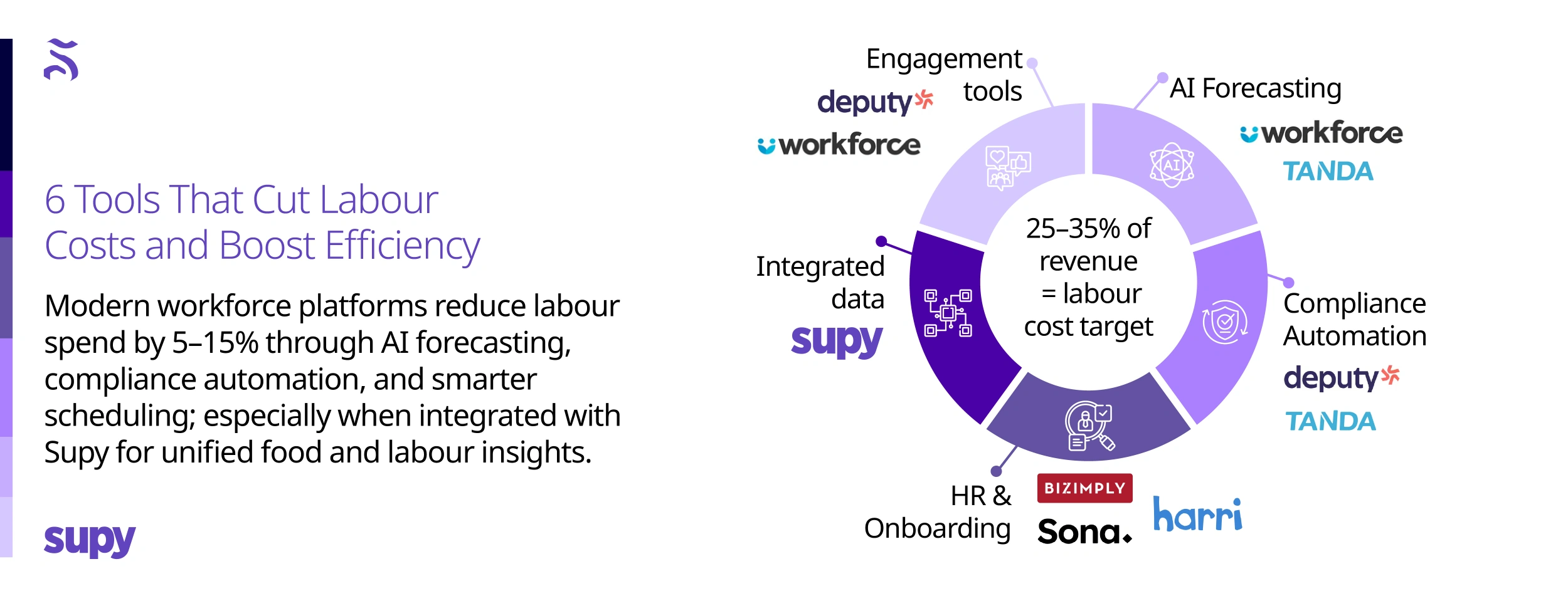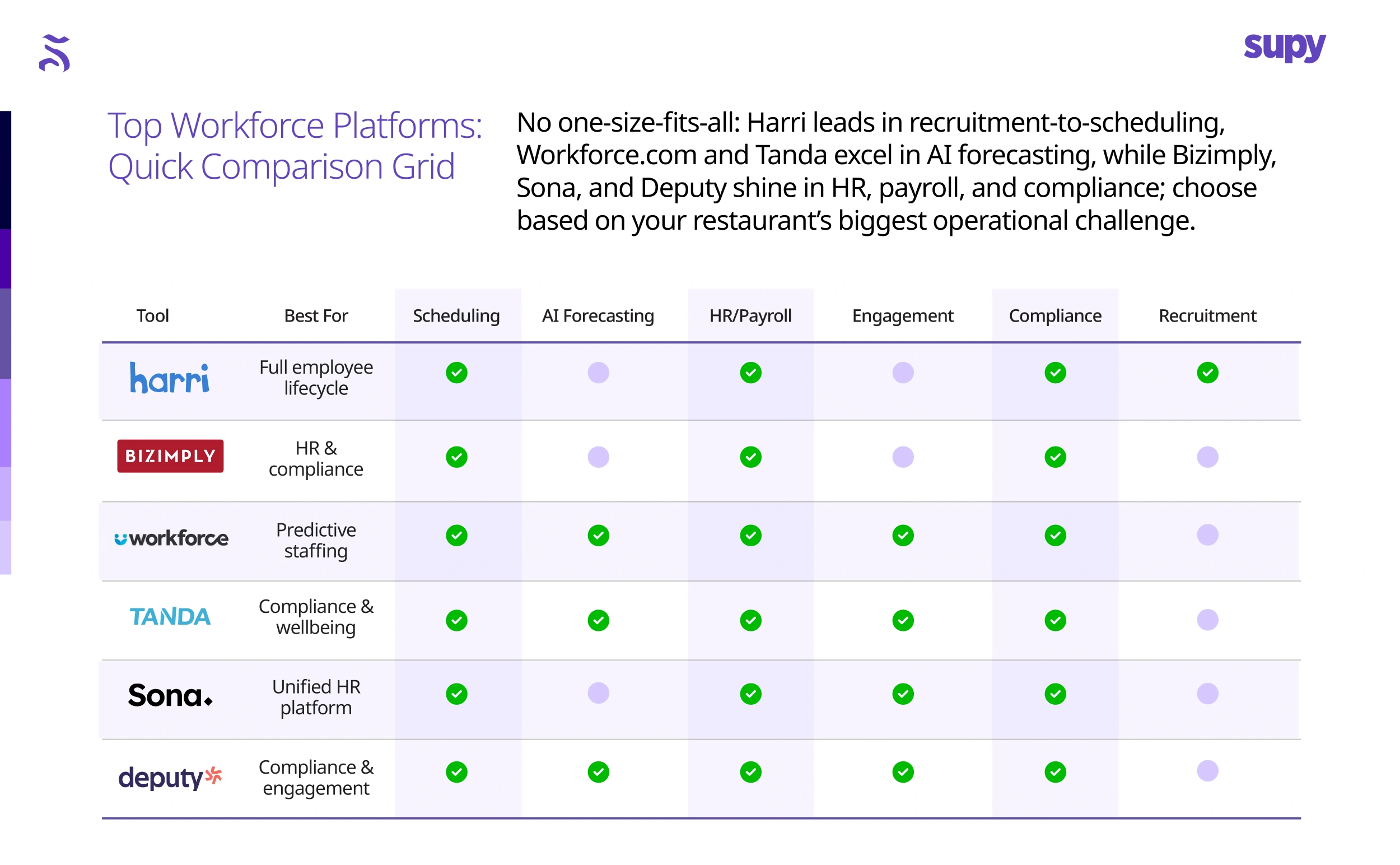Top Restaurant Workforce Management Tools for Multi‑Branch Restaurants

Busy lunches, slow afternoons, weekend rushes — and they still must run in sync. Many operators juggle spreadsheets, texts and phone calls to fill shifts. Turnover bites, labour costs creep up, and compliance stays risky. Black Box Intelligence (2024) reports:
Limited-service hourly turnover peaked at 173% (Q1 2022) and was 135% in Q3 2024.
Full-service hourly turnover eased from a 125% peak (2021) to 96% in Q3 2024.
Replacing an hourly team member costs ~$2,305; a general manager ~$16,770.
Overall U.S. restaurant turnover fell to 73.9% in 2023 (lowest since 2017), yet only 36% of restaurants hit labour-cost targets.
Operators need smarter tools to regain control.
This guide helps multi-unit leaders across operations, HR, finance and franchising modernise workforce management. It reviews six solutions (Bizimply, Workforce.com, Tanda, Sona, Deputy and Harri), highlights key features and training tips, shares a Supy partner case study, and shows how integrating these tools with Supy unifies labour and food costs for better, faster decisions.

Why multi‑branch restaurants need data‑driven labour management
Managing staff across multiple locations magnifies labour challenges. Each branch has unique sales patterns and staffing needs; one may need extra servers on Saturdays, while another faces lunch‑hour queues. Without a centralised system, managers over‑schedule to avoid being short‑staffed, inflating wages and overtime. Under‑scheduling leads to poor service, stress, and higher turnover. The average cost to replace a back‑of‑house worker is $1,491, and management replacement costs are $2,611 per position. These costs accumulate quickly in multi‑unit operations.
Labor costs vary by concept and region but generally sit around 25–35 % of revenue — lower for QSRs, higher for full-service and fine dining. Rising wages and shortages are squeezing margins, making smart scheduling tools essential. Technology now helps forecast demand, optimize shifts, enforce breaks, and track time automatically, cutting overtime and boosting compliance.
For multi-branch operators, automation also mitigates legal risks by flagging overtime limits, inserting required breaks, and ensuring accurate pay. Modern platforms even let staff swap shifts or request time off, reducing admin and improving engagement. The next sections explore six leading solutions tackling these challenges.
Bizimply

Bizimply is an operator‑focused platform built for hospitality, retail, and healthcare. It centralises scheduling, time and attendance, HR, and payroll into one cloud‑based dashboard.
Features & Benefits
- Employee scheduling and shift management – Build rotas quickly with drag‑and‑drop tools; view labour costs and staffing levels in real time.
- Time and attendance – Track clock‑ins via tablet, mobile, or biometric terminals; geofencing ensures staff are on site.
- Mobile access – Managers can approve shifts and requests from anywhere; employees see schedules, submit availability, and request time off.
- Document management & onboarding – Store contracts, training documents, and certifications; automate onboarding workflows for new hires.
- Dashboards and HR reporting – Customisable dashboards show labour costs, sales versus labour, and compliance status; export reports for payroll and auditing.
- Leave management and payroll integration – Track vacation and sick leave; export clean timesheets to payroll providers.
Training Tips
- Set up custom dashboards: Create views for labour cost percentage, overtime hours, and sales per labour hour. This helps managers spot issues at a glance.
- Use role‑based access: Limit sensitive data to managers while giving employees self‑service access to schedules and personal records.
- Integrate onboarding: Add digital onboarding forms so new hires complete paperwork before their first shift. Coupled with Supy’s procurement system, you can also order uniforms and equipment ahead of time.
Hidden Gems
- Employee self‑service – Staff can update personal information, download payslips, and swap shifts without manager intervention.
- Performance management – Track employee KPIs and leave notes on performance. Use this data in annual reviews or to identify training needs.
Bizimply is ideal for operators who need strong HR functionality, document storage, and compliance controls. It scales from single sites to multi‑branch enterprises with role‑based permissions.
Workforce (Tanda in UK/NZ)

Workforce offers an extensive suite of scheduling, time tracking, HR, and forecasting tools. It differentiates itself with powerful AI‑driven labour forecasting.
Features & Benefits
- Scheduling Cloud – Intelligent rostering predicts demand based on historical sales, reservations, and foot traffic; automatically fills shifts and handles absence management.
- Time & attendance – Employees clock in via biometric terminals, mobile apps, or kiosks; real‑time data feeds into payroll.
- AI forecasting – The platform uses historical POS data, reservations, weather forecasts, and events to predict staffing needs. This helps operators schedule the right number of employees and reduce overtime.
- Engagement tools – Built‑in chat and messaging allow managers to communicate with teams. Surveys capture employee sentiment.
- HR modules – Onboarding, HRIS, and performance reviews streamline the employee lifecycle.
Training Tips
- Plan for holidays and events: Use the AI forecasting module to model how holidays like Ramadan or national days affect traffic. Adjust schedules accordingly.
- Create repeatable templates: Build templates for typical weekdays, weekends, and special events. Templates save time and ensure consistent labour budgets.
- Communicate through the app: Encourage staff to use the messaging feature for shift trades and updates. This reduces texts and emails and keeps all information in one platform.
Hidden Gems
- Shift filler – The system automatically identifies available staff and sends notifications to fill open shifts or cover call‑outs.
- HRIS data analytics – Pull insights on turnover, overtime, and training completion across locations. Combine this data with Supy’s purchasing analytics to identify links between labour and food costs.
Workforce.com suits operators who prioritise predictive staffing and need advanced analytics for labour and HR metrics. In complex, multi‑branch environments, its AI helps maintain staffing levels despite fluctuating demand.
Tanda (Australia)

Tanda, originally Australian, powers workforce management for hospitality, retail, and healthcare. It offers a modular suite: HR Cloud, Engagement Cloud, scheduling, and payroll.
Features & Benefits
- Smart scheduling – Build rosters with drag‑and‑drop tools and view live wage costs. The system accounts for labour laws and award rates (important in Australia).
- AI labour forecasting – Pull data from POS systems, reservations, and even weather to predict demand. This is particularly useful for seaside restaurants or venues with outdoor seating.
- Engagement Cloud – Survey tools capture employee sentiment, and wellbeing dashboards display metrics such as engagement and fatigue. Alerts flag when teams are overworked.
- Payroll accuracy – Integrates with payroll providers to ensure compliant pay runs and award interpretations.
- Dynamic shift filler – Automatically contacts available staff when someone calls in sick. Staff can claim extra shifts via the mobile app.
Training Tips
- Use the dynamic shift filler: Encourage managers to rely on the automated call‑out feature rather than texting individuals. It speeds up back‑fills and keeps the process fair.
- Monitor wellbeing dashboards: Regularly review the sentiment and engagement metrics. Address fatigue before it leads to turnover.
- Integrate weather data: For seaside and outdoor locations, plug in local weather feeds so the forecasting engine predicts spikes when the sun shines.
Hidden Gems
- Employee app – Staff can swap shifts, request leave, and view payslips. This reduces administrative work and empowers employees.
- Compliance engine – Tanda automatically applies penalty rates and overtime based on labour laws and award agreements. This feature is essential for operators in Australia or any region with complex labour regulations.
Tanda is a strong choice for operators seeking robust compliance tools and wellbeing dashboards. Its integration with POS and weather data makes it highly predictive.
Sona

Sona positions itself as an all‑in‑one workforce and HR platform designed for multi‑location hospitality operators. It unifies scheduling, timesheets, payroll, and HRIS in a single interface.
Features & Benefits
- Rostering – Build schedules quickly with templates, drag‑and‑drop functionality, and wage cost indicators.
- Leave management & approval workflows – Employees request leave via the mobile app; managers approve or decline with one click. Automated workflows ensure requests follow the right chain.
- Time sheets & payroll – Timesheets sync with payroll providers, reducing manual data entry.
- Reporting & analytics – View labour costs, hours worked, and compliance metrics across locations. Export data to Excel or integrate with Supy for consolidated dashboards.
- People directory & document storage – A searchable directory of all employees with integrated document storage for contracts, certifications, and policies.
Training Tips
- Create approval workflows: Set up multi‑step approvals for time off or shift swaps. For example, frontline managers can approve holiday requests up to three days, while HR approves longer periods.
- Use mobile notifications: Configure push notifications for training reminders, policy updates, or shift changes to keep employees informed.
- Segment reports by location: Analyse labour costs by branch to identify high‑spend units. Pair these insights with Supy’s procurement data to see if high labour costs correlate with high food wastage.
Hidden Gems
- People directory – A central database with photos, contact details, and roles helps managers identify staff across locations.
- Document storage in the HR Cloud – Upload and organise employee certifications and policy documents. Staff can access them via the mobile app, reducing paper records.
Sona is ideal for operators wanting a unified HR and payroll system. Its approval workflows and mobile notifications improve accountability and communication across multiple sites.
Deputy

Deputy is widely used in hospitality and retail for its intuitive scheduling and compliance features. It emphasises simplicity and engagement while offering robust labour law protections.
Features & Benefits
- Efficient scheduling – Build rosters quickly, drag and drop shifts, and forecast labour against sales. Use templates for busy or slow periods.
- Time & attendance – Employees clock in using tablets or mobiles. Photo clock‑in and geolocation reduce time theft.
- Wage & hour compliance – Automatically calculates meal and rest breaks, overtime, and penalty rates. Alerts managers when schedules violate labour rules.
- Demand forecasting – Use historical sales, footfall, and weather data to align staffing with demand. The system highlights when you’re over‑ or under‑staffed.
- Engagement tools – A “News Feed” lets managers share announcements, policies, and updates. Employees can comment and react.
Training Tips
- Use demand forecasting: Compare forecasted sales to scheduled labour. Adjust shifts to match expected foot traffic or delivery orders.
- Automate break compliance: Configure meal and rest break rules. Deputy will insert breaks into schedules and remind employees to take them.
- Leverage the News Feed: Post daily specials, training videos, and recognition shout‑outs. Encourage staff to engage and ask questions.
Hidden Gems
- Shift‑swap feature – Employees can swap shifts with manager approval through the app. This reduces no‑shows and empowers employees.
- On‑demand pay – In some markets, Deputy partners with payroll providers to offer on‑demand wages, boosting financial wellbeing and retention.
Deputy suits operators who prioritise compliance and employee engagement. Its intuitive interface makes adoption easy for managers and staff.
Harri

Harri combines applicant tracking with scheduling and time tracking, covering the entire employee lifecycle. It’s popular in hospitality and quick‑service chains.
Features & Benefits
- Applicant tracking and hiring – Post jobs, screen candidates, schedule interviews, and send offer letters. Applications feed directly into the HR system.
- Onboarding & document collection – New hires complete forms and upload documents via mobile, reducing paperwork.
- Scheduling and time tracking – Build rosters, manage shift swaps, and track hours. Integrate with payroll providers for accurate pay runs.
- Time‑off management and communication – Employees request leave through the app; managers can message staff individually or by role/location.
- Advanced analytics – Analyse labour costs, sales per labour hour, and overtime by location. Use predictive models to forecast sales and plan staffing.
Training Tips
- Automate onboarding flows: Build customised onboarding checklists for each role. New hires are guided through paperwork, training modules, and orientation.
- Use custom analytics: Create reports comparing labour costs and sales across locations. Identify branches with high overtime or low sales per labour hour.
- Leverage skill‑based scheduling: Tag employees by skill (barista, bartender, prep cook) and let Harri auto‑assign staff to shifts based on skills and labour cost targets.
Hidden Gems
- Start‑ and end‑of‑shift surveys – Collect feedback from employees at the end of each shift to gauge workload and morale. Use the results to spot training needs or staffing issues.
- Auto‑assignment based on skills – The system considers both skills and labour cost budgets when filling shifts, ensuring the right mix of experience and cost efficiency.
Harri is ideal for operators who want recruitment and workforce management in one platform. Its analytics and skills‑based scheduling are especially useful for large or specialised teams.
Comparative Insights & Recommendations
Choosing the right workforce management tool depends on your restaurant’s size, complexity, and integration needs. Below is a concise comparison table summarising the strengths of each solution.

When selecting a solution, consider the scale of your operation. Bizimply suits operators who need robust HR management and document control. Workforce.com and Tanda excel in AI forecasting; they’re ideal if you operate in markets with volatile demand or complex labour rules. Sona is best for those seeking a unified HR and payroll platform. Deputy offers strong compliance features and employee engagement tools that are easy to adopt. Harri stands out if you want recruitment and scheduling in one system. We recommend starting with a trial and involving your operations and HR teams in the evaluation. Integrating your chosen tool with Supy’s procurement and inventory platform will give you real‑time visibility into labour and food costs, enabling data‑driven decisions.
Conclusion
Labour is one of the largest controllable costs for restaurants, yet it remains notoriously difficult to manage. High turnover (over 70 %), increasing wages, and complex compliance requirements strain margins. Data shows that most restaurants aim to keep labour costs between 20 % and 30 % of revenue and that efficient operations achieve this through smarter scheduling and forecasting. Modern workforce management tools, Bizimply, Workforce.com, Tanda, Sona, Deputy, and Harri, provide the technology to align staffing with demand, enforce compliance, empower employees, and reduce turnover. When paired with Supy’s procurement and inventory platform, operators gain a holistic view of labour and food costs to make informed decisions.
To see how these solutions can help your multi‑branch restaurant reduce costs, improve scheduling accuracy, and boost team morale, book a demo with Supy. Our experts will show you how to integrate workforce management with procurement and inventory tools for maximum efficiency.
Related Resources




